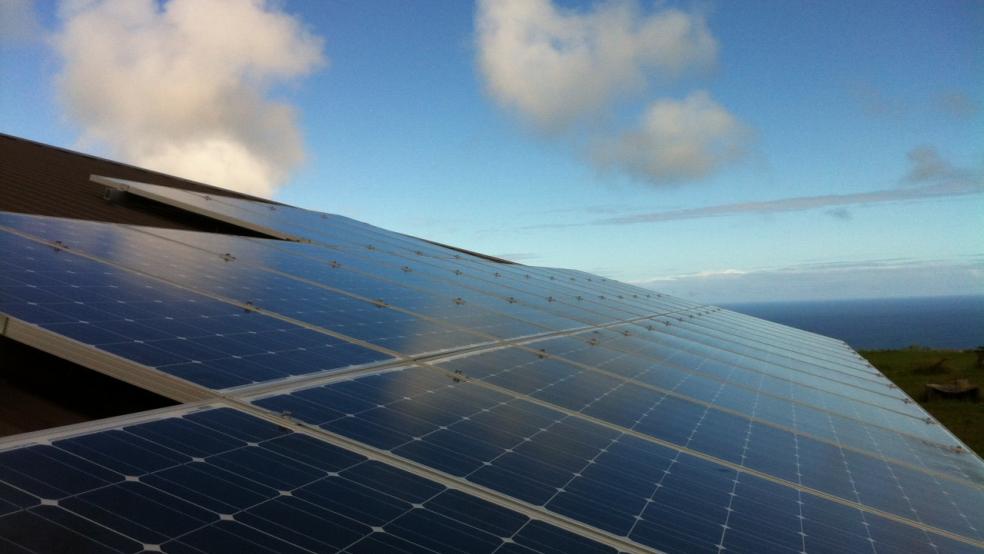During a White House meeting with Republican Congressional leaders on June 6, President Trump discussed plans for his proposed US-Mexico border wall. As Axios reported, he pitched covering the wall in solar panels and using the generated electricity to pay for its construction.
Estimations of how much energy a solar border wall would actually produce vary, depending on the size of the array and the wall itself. But some companies are already imagining what it would look like.
Related: Can We Afford Trump’s Border Wall With Mexico?
How much electricity a hypothetical solar border wall could generate
Oregon-based solar installation firm called Elemental Energy calculated that a wall with 10-foot-high solar paneling would generate approximately 7.28 gigawatt-hours (GWh) of electricity each day.
Elemental's co-owner, John Grieser, broke down the math to Business Insider like this:
In his hypothetical calculation, the solar panels would be mounted to the wall at a fixed tilt and orientation (meaning they wouldn't move to track the sun, which is a more expensive option), Grieser says. Each panel would feature 72 solar cells, and measure 78 inches high.
The US southern border measures nearly 2,000 miles across four states, but only about half of that length is on unobstructed land. A thousand miles converts to 63.36 million inches. When you divide that by the size of each panel (78 inches), you get 812,308 columns of panels (oriented in landscape).
Typically, fixed tilt solar arrays feature five rows of panels, and a 30-degree tilt would create a 10-foot-tall array. Trump reportedly said the wall would be 40 to 50 feet high, but Grieser says Elemental's calculations are for a shorter array.
Related: Before the Wall: 18 Photos of the US-Mexico Border
Multiplying 812,307 by five, you get 4,061,538 panels in total. Since 72-cell modules usually produce 350 watts (W), you end up with about 1.4 billion W (or 1.4 GW) of power. Grieser says that's enough to power 220,000 average-size homes annually.
He notes the US-Mexico border is very sunny. Even with a system efficiency of 80% the 1.4 GW array would generate about 7.28 GWh of electricity daily (or 2,657.2 GWh annually) — worth over $106 million per year via a competitive utility-scale Power Purchase Agreement (PPA) at $40/MWh (i.e. a contract between the electricity seller and buyer that sets the price of the solar energy from the grid).
"It was a late night of napkin math," Grieser says. "I don't support a wall, but if it has to be built, and it's completely out of my control and influence, then we might as well put some solar panels on it."
Other analysts predict a solar wall would generate much more electricity. Jigar Shah, co-founder of Generate Capital, estimates 6,600 GWh annually, while clean energy consultant Adam Siegel places the wall's capacity at 8,431 GWh annually.
Related: Trump’s Wall, By One Estimate, Could Cost $70 Billion
Gleason Partners LLC, a Las Vegas-based architecture firm, proposed a solar border wall to the Department of Homeland Security in its official open call in early 2017.
The possible cost of a solar array installation on a border wall
When Trump floated the idea of a solar wall to GOP leaders, he mentioned that the electricity produced would help pay for the wall itself. Mexico has said it will not foot the bill.
A ground-mounted solar array without trackers will likely cost $1 per watt by 2020, according to the US Department of of Energy (DOE). But as MIT Technology Review notes, that figure doesn't consider other costs, like transmission lines to deliver the power, software to regulate the flow of intermittent solar power onto the grid, and energy storage systems.
Today, the average price per watt is about $3, according to a recent report from Berkeley.
A 1.4 GWh array that costs $1/W to install would cost $1.4 billion. At $3/W, the solar array would total $4.2 billion.
That cost also does not take into account the price of the wall's construction and maintenance, which other analysts have estimated could reach anywhere from $10 billion to $2 trillion.
At the Department of Homeland Security's estimate of the wall's construction at $21.6 billion, a solar-powered barrier would eventually pay for itself (if it continues to produce over $106 million per year of electricity), Grieser says. But it would take decades.
This article originally appeared on Business Insider. Read more from Business Insider:
The best new feature coming to Apple Music won’t be on your iPhone
Preet Bharara hits back at Paul Ryan's 'silly' excuse for Trump's missteps




